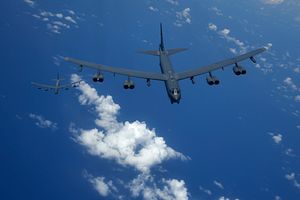Two U.S. Air Force B-52H Stratofortress strategic bombers flew an 11-hour mission over the East China Sea and Sea of Japan on January 28. The B-52H mission was flown in support of U.S. Indo-Pacific Command’s continuous bomber presence mission in the Indo-Pacific region, according to the U.S. Air Force (USAF).
The two B-52H strategic bombers are part of a USAF contingent currently forward-deployed to Andersen Air Force Base on Guam in the Western Pacific. The two bombers departed from Guam for their mission over East China Sea on January 28 and were refueled mid-air by a Boeing KC-135 Stratotanker. As I explained previously:
U.S. Air Force B-52Hs have repeatedly transited the airspace over the East and South China Seas in recent months. The service redeployed the B-52H to Guam as part of the U.S. Indo-Pacific Command’s continuous bomber presence mission in the Asia-Pacific region in January. B-52Hs last deployed to Guam in July 2016. The B-52Hs took over responsibility from the B-1B Lancer heavy strategic bombers of the USAF’s 9th Expeditionary Bomb Squadron (EBS) of the 7th Bomb Wing, which deployed to the region in February 2017.
Two B-52Hs transited the East and South China Seas in September 2018, a mission which the Chinese Ministry of Defense officially called provocative. “As for the provocative action taken by the U.S. military aircraft, we are firmly against it and we will take all necessary means to safeguard our rights and interests,” a ministry spokesperson was quoted as saying at the time. The last reported B-52 mission in the vicinity of the South China Sea was in November in 2018.
Two B-52Hs and two U.S. Navy P-8A Poseidon maritime patrol aircraft also conducted a training exercise in the vicinity of Japan over the East China Sea in August 2018. The principal aim of the exercise was to improve combined and joint service interoperability. (The U.S. Navy has recently awarded U.S. aircraft maker Boeing a $2.4 billion production contract for the next batch of 19 P-8A Poseidon maritime patrol aircraft.)
The USAF’s current B-52H long-range, heavy strategic bomber inventory consists of 58 aircraft. The bombers are capable of flying at high subsonic speeds at altitudes up to 50,000 feet (15,166.6 meters) and can carry nuclear cruise missiles and a conventional payload of up to 70,000 pounds (31,500 kilograms).
Under the 2010 New Strategic Arms Reduction Treaty (START), 41 B-52Hs were denuclearized. It is unclear whether the B-52Hs that conducted the January 28 mission are nuclear-capable.”We do not discuss the nuclear capabilities of our operational bomber aircraft to that level of specificity for security reasons,” a Pacific Air Forces (PACAF) spokesperson said in a January 30 email to The Diplomat.
“The denuclearized variant of the B-52H carries JASSM [AGM-158B Joint Air-to-Surface Standoff Missile] and JASSM-ER [Extended-Range] long-range, radar-evading cruise missiles, whereas nuclear-capable bombers carry the nuclear-tipped AGM-86 air-launched cruise missile,” I explained previously.































